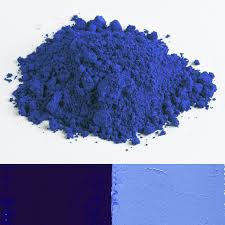Characteristics of Pigment Bleu Outremer
2024-05-17
Pigment Bleu outremer, also known as ultramarine blue, is a deep blue pigment originally derived from the semi-precious stone lapis lazuli. It has a rich history and is notable for its vibrant color and extensive use in art.
Historical Context
- Origins: The name "ultramarine" comes from the Latin "ultramarinus," meaning "beyond the sea," a reference to its importation from mines in Afghanistan to Europe via maritime trade routes during the Middle Ages and Renaissance.
- Lapis Lazuli: Historically, the pigment was made by grinding lapis lazuli into a fine powder. This process was labor-intensive and costly, making ultramarine blue one of the most expensive and highly prized pigments.
- Synthetic Ultramarine: In the 19th century, a synthetic version was developed, significantly reducing the cost. The French chemist Jean-Baptiste Guimet is credited with discovering the synthetic production method in 1828.
Characteristics
1. Color Properties:
- Hue: Deep, intense blue with a slightly reddish undertone.
- Lightfastness: Highly lightfast, meaning it resists fading when exposed to light.
- Opacity: Semi-transparent, allowing for layering and glazing techniques in painting.
2. Chemical Composition:
- Natural Ultramarine: Composed mainly of the mineral lazurite, along with other minerals such as calcite and pyrite.
- Synthetic Ultramarine: Made from a combination of silica, alumina, sodium carbonate, and sulfur. It mimics the color and properties of the natural version but is more uniform and affordable.
3. Stability:
- Chemical Stability: Generally stable and non-reactive, but can be sensitive to acids which may cause color changes or degradation.
Uses in Art and Industry
- Fine Art: Ultramarine blue is a staple in the palettes of artists, particularly favored in oil and acrylic painting for its vivid color and mixing capabilities. It is used in watercolor, fresco, and tempera techniques as well.
- Cultural Significance: Historically, it was used in illuminated manuscripts, religious icons, and Renaissance paintings, often reserved for depicting the robes of the Virgin Mary and other important figures due to its cost and visual impact.
- Modern Applications: Beyond fine art, it is used in printing, cosmetics, plastics, and coatings due to its stability and vibrant hue.
Key Considerations for Artists
1. Mixing: Ultramarine blue mixes well with other pigments, creating a wide range of shades and tones. It is often used to create purples when mixed with reds and greens when mixed with yellows.
2. Layering: Due to its semi-transparent nature, it is ideal for glazing techniques, where thin layers of color are applied to achieve depth and luminosity.
3. Surface Preparation: When using ultramarine blue in oil painting, ensure the surface is properly primed to prevent the pigment from sinking into the substrate and losing its vibrancy.
Care and Handling
- Storage: Store in a cool, dry place, away from direct sunlight and moisture to preserve the pigment's quality.
- Usage: Handle with care, especially when using powdered forms to avoid inhalation or ingestion. Use appropriate protective equipment such as masks and gloves if necessary.
Conclusion
Pigment Bleu outremer, or ultramarine blue, is a historically significant and artistically valued pigment known for its intense and vibrant blue color. Whether derived from natural lapis lazuli or synthesized, it remains a favorite among artists for its versatility, stability, and rich hue, continuing to inspire and enhance works of art across various media.



